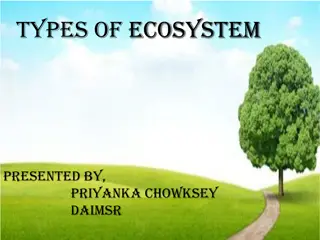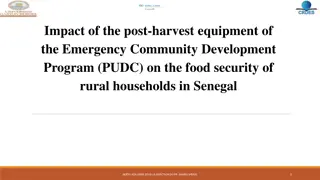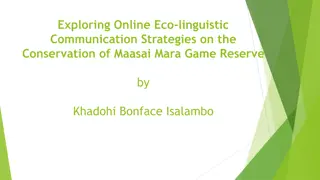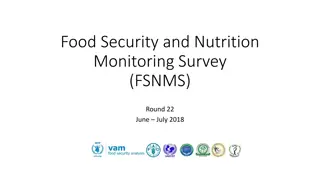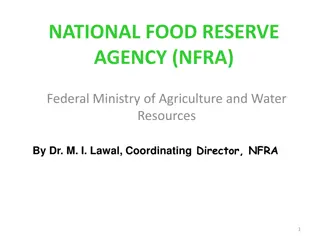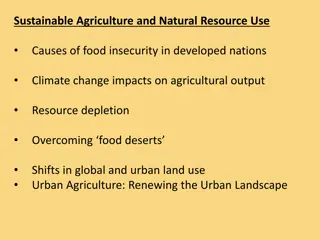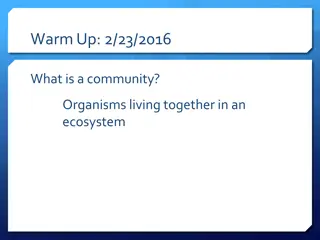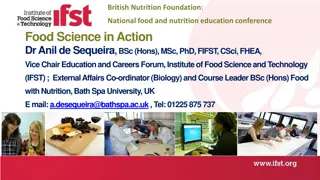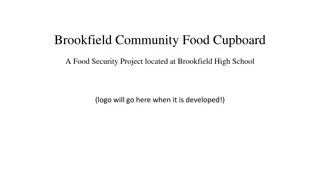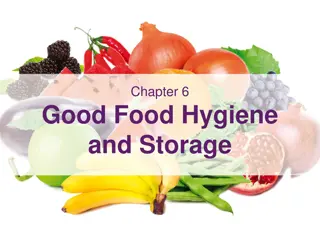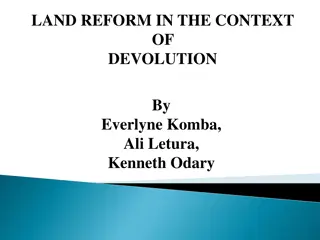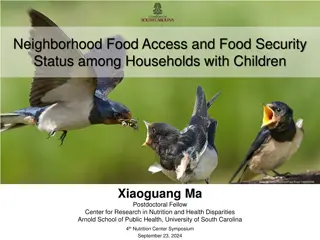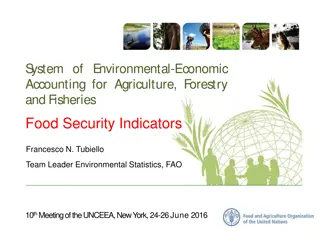Food Security and Ecosystem Impacts in Maasai Mara
Patterns of land use in the Maasai Mara ecosystem have evolved, impacting food security and ecosystems. This study explores the role of pastoralism in achieving food security and maintaining the Mara ecosystem, addressing key objectives and the rationale behind supporting pastoralist communities.
Download Presentation

Please find below an Image/Link to download the presentation.
The content on the website is provided AS IS for your information and personal use only. It may not be sold, licensed, or shared on other websites without obtaining consent from the author.If you encounter any issues during the download, it is possible that the publisher has removed the file from their server.
You are allowed to download the files provided on this website for personal or commercial use, subject to the condition that they are used lawfully. All files are the property of their respective owners.
The content on the website is provided AS IS for your information and personal use only. It may not be sold, licensed, or shared on other websites without obtaining consent from the author.
E N D
Presentation Transcript
FOOD SECURITY AND THE ECOSYSTEM BY PROF. MARY WALINGO VICE CHANCELLOR,MAASAI MARA UNIVERSITY
INTRODUCTION The patterns of land use in the Maasai Mara ecosystem have changed from nomadic pastoralism to sedentary pastoralism to agropastrolism and in some cases pure agriculture or cultivation ( Muriuki et al,2005). While food security has improved around the world as a result of increased agriculture, this has been accompanied by a significant decline in the state of ecosystems and the services they provide. That pastoralism can support biodiversity through an integrated livestock-wildlife system (IWLM) than either livestock or wildlife systems alone. Pastoralist production contributes substantially to food security and sustainable land use while maintaining landscape level ecosystems, but the co-benefits to ecosystems, biodiversity and other land users are not fully acknowledged (Barrow and Mogaka 2007,Davies 2008,Flitan et al,2013).
PROBLEM STATEMENT AND OBJECTIVES OF STUDY Despite the substantial contribution of pastoralism to achievement of food security and maintenance of ecosystems, the land users (Maasai community) have not been fully acknowledged. Based on this premise, this study seeks to investigate the role of pastoralism in achievement of food security and maintenance of the Mara ecosystems. The specific objectives are as follows a) Give a rationale for supporting pastoralism to achieve food security. b) Explain the profile of the Maasai food and consumption patterns. c) Describe the Maa livelihood strategies in securing food within their ecosystem
HOW PASTORALISM AFFECTS THE ECOSYSTEMS Livestock can and do compete with several species of wildlife for forage. Wildlife appear to avoid heavily grazed areas completely In group ranches wildlife probably avoid areas close to settlements because livestock remove most of the forage but cluster at intermediate distances from settlements to access moderately grazed grasslands. Fragmentation prevents livestock and wildlife from reaching landscape.
RATIONALE FOR PASTORALISM TO SUPPORT FOOD SECURITY Pastoralists form a large portion of the world s poor. Supporting pastoralists is supporting a large portion of those in the agricultural sector who live in poverty. The poverty experienced in pastoralists areas could be addressed through well placed investment in the untapped potential that exists there. (Barrow and Mogaka,2007) Pastoralism is projected to be one of the livelihoods hardest hit by climate change (Mwangi and Ostrom,2009). Supporting pastoralism bolsters a type of food production carried out by those who already posses expert knowledge in this regard (Davies,2008) Supporting pastoralism contributes to maintenance of the dry lands ecosystem services (Flintan et al,2013). Pastoralism accounts for over 90% of pastoral communities diet and more specifically the Maa community as captured in the profile of their foods
PROFILE OF MAASAI TRADITIONAL FOODS Meat was shown to be an important source of energy and protein for the Maasai people. It was consumed during special occasions such as circumcision and marriage Meat and bones were boiled in water with herbs to produce soup exceptionally good source of iron and calcium and contributed protein and vitamin A. was ingested from cow without being boiled and was drunk by all age groups. This was a source of protein, energy and calcium was made by fermenting the fresh milk for a day for a day. It was for young boys not yet at circumcision age were major consumers Soup Blood Fresh milk Sour milk (Kule naisamis) Yorghurt (Kule naoto) Cow colostrum (isikitok) was fermented for about four days and stored in airtight containers. All age groups took this milk. when still thick and yellow in colour is considered nutritious and mostly given to young children. This is a source of protein and vitamin A.
MAA FOOD CONSUMPTION PATTERNS PERIOD Birth to two years FOOD AND BEHAVIORAL ATTRIBUTES Breast feeding , cream from cow s milk (engorno). burnt donkey dung was added to cream to prevent cold and pneumonia. herbal roots given as stimulators, dewormers and antidiuretics. Girls and boys consumed diet consumed by adults. children consumed wild fruits when they took cows for grazing and shared harvest mostly with mothers and sisters. Male adults considered fruit as food for children and women. For girls, a mixture of sour milk and fresh blood while boys were encouraged to drink yoghurt and blood daily and dried meat Boys graduated into morans and official foods were fresh milk, fermented milk and yoghurt in large amounts. Meat, blood, soup and milk as well as Ugali (maize meal),githeri,kales,cabbages and beans Liver and kidney, dried meat in solid fat, fresh and fermented milk After circumcision Post circumcision Adults Pregnant women Post natal and Lactating women Wild fruits and roots Fresh blood and milk, porridge with blood added, soup with various types of herbs were consumed mostly by women and children
MAA LIVELIHOOD STRATEGIES IN SECURING ACCESS TO FOOD- HERD MANAGEMENT Keeping sufficiently large herds to accommodate anticipated losses resulting from drought Herd mobility enhances the optimal use of a heterogenous environment Destocking through sales before and during crisis Managing a variety of livestock species (cattle,sheep,goats) and production characteristics Allocation of animals with friends and relatives on special loan arrangements allowing the reclaiming of this animals in times of need Breeding animals with low basal metabolic rates and high milk and meat output Dipping the animals in aracide bath to prevent tickborne diseases Castrating animals which helps to fatten in order to make them drought resistant
RESOURCE MANAGEMENT Certain dry season grazing areas(hilly areas) are set aside in cooperative agreement with other households Individual households refrain from using certain patches of land nearby their permanent homesteads. Making improvements in water availability through shallow wells and boreholes Food preservation through drying of meat or storing of cheese. These traditional practices are on the decline. Diversification of the household economy through engagement in rainfed and irrigated agriculture,wage employment and commercial business Bank accounts are being increasingly used to store money
CHANGE IN FOOD HABITS Reduction of food intake by the pastoralists. Less home produced milk is available Change in food intake. Milk is mixed with herbs. More goats and sheep are milked. Less favored parts like the heart,liver,tongue,pancreas and heart are eaten. Terribly emaciated animal is boiled, roasted or cooked. Sales of animals and skins increase to buy foods from the shops mainly maize meal and sugar. Gathering of fruits, berries and roots
Change in herd and resource management Elderly people take over livestock herding, while younger people search for distant pastures. Use of dry season areas,renting of outside pastures or long distance trekking to areas controlled by other groups Collections of grasses,tree pods and leaves as fodder,especially for young calves and rams Animal intake of drinking water is changed from every day to once in two days Milking practices are changed as more milk is left for calves and less milk is consumed by people
SOCIAL SUPPORT NETWORK Assistance is sought from relatives and friends(money,labour,animals,food) Praying and sacrificing a ram of specific colours (said to be one on the decrease) Relief programmes organized by government or church
CONCLUSION In recent years, members of the community have grown dependent on food produced in other areas, a pattern pronounced during protracted drought caused by destruction of ecology. The contribution of traditional diets to energy and nutrients is declining. Young members are losing indigenous knowledge on food use and rely more on Kenyan conventional foods. The Maa have several coping strategies in relation to food security. The Maasai are experiencing food security due to the changes in the ecosystem
RECOMMENDATIONS Preservation and maintenance of the Maasai traditional indigenous food based knowledge can be done through continuous education of young members about their traditional foods and cultural contexts Maasai pastoralists can achieve their food security through a) Effective management of the pastoral production system; b) Sustainable use of environmental resources especially water c) An informed and responsive policy framework Efforts to promote Integrated Wildlife and Livestock Management (IWLM) need to ensure access for pastoralists to seasonal grazing and water and limit negative effects of wildlife integration such as disease transmission and crop damage.


